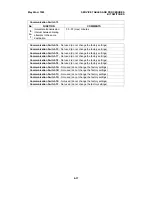
Notes
1. If a setting is not required, store FF in the address.
2. Tone frequencies are stored as look-up tables in hex code. For each pa-
rameter, there is a look-up table for each country that uses it. The tables
are given following this page. For each parameter, do not input a RAM
value that is not included in the table.
3. Italy and Belgium only
RAM address 807F5E: the lower four bits have the following meaning.
Bit 2 1: International dial tone cadence detection enabled (Belgium)
Bit 1 Not used
Bit 0 1: PSTN dial tone cadence detection enabled (Italy)
If bit 0 or bit 2 is set to 1, the functions of the following RAM addresses
are changed.
807F08 (if bit 0 = 1) or 807F38 (if bit 2 = 1): tolerance for on or off state
duration (%), and number of cycles required for detection, coded as in ad-
dress 807F33.
807F0B (if bit 0 = 1) or 807F3B (if bit 2 = 1): on time, hex code (unit = 20
ms)
807F0C (if bit 0 = 1) or 807F3C(if bit 2 = 1): off time, hex code (unit = 20
ms)
4. Pulse dial parameters (addresses 807F4A to 807F4F) are the values for
10 pps. If 20 pps is used, the machine automatically compensates.
5. The first ring may not be detected until 1 to 2.5 wavelengths after the time
specified by this parameter.
6. The calculated level must be between 0 and 10.
The attenuation levels calculated from RAM data are:
High frequency tone: - 0.5 x N
807F52/807F54
dBm
Low frequency tone: - 0.5 x (N
807F52/807F54
+ N
807F53
) dBm
Note: N
807F52
, for example, means the value stored in address
807F52(H)
7. 807F4A: Europe - Between Ds opening and Di opening, France - Be-
tween Ds closing and Di opening
807F4D: Europe - Between Ds closing and Di closing, France - Between
Ds opening and Di closing
May 22nd, 1995
SERVICE TABLES AND PROCEDURES
NCU PARAMETERS
4-51
















































